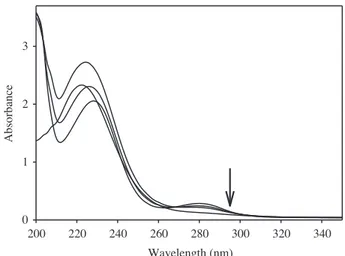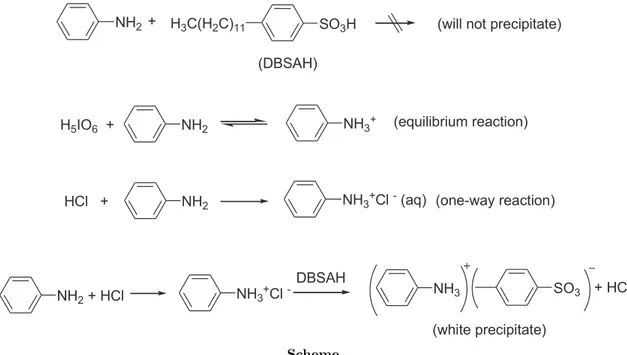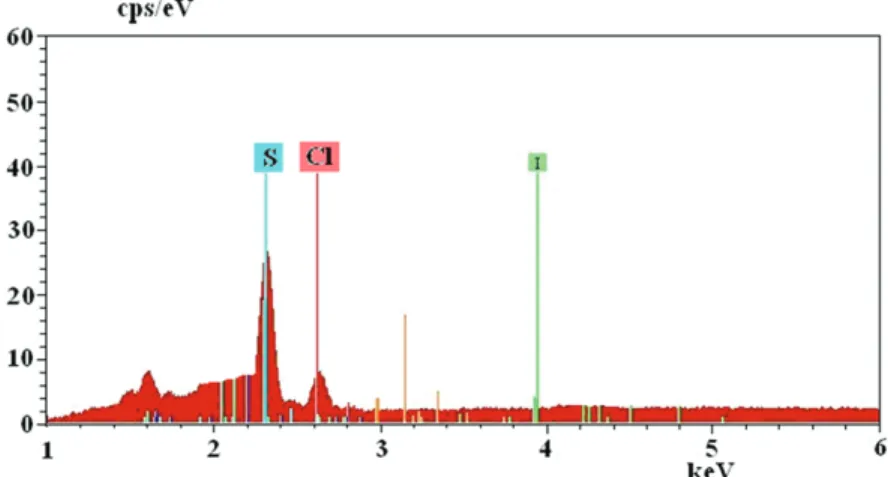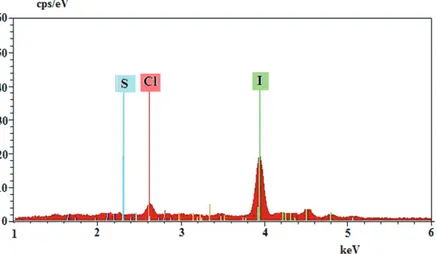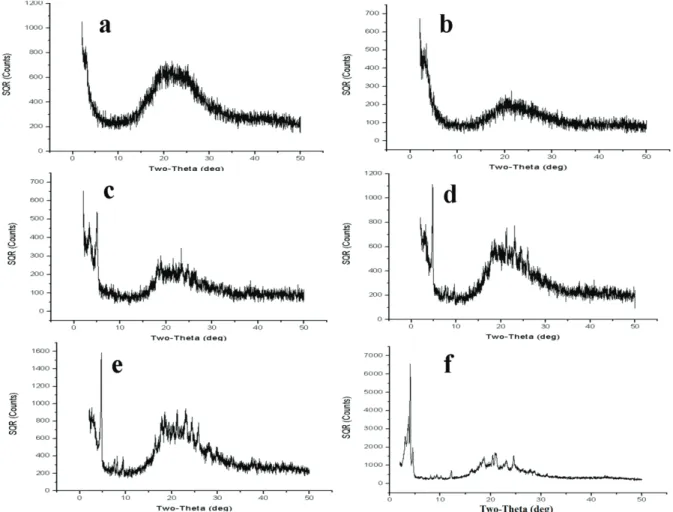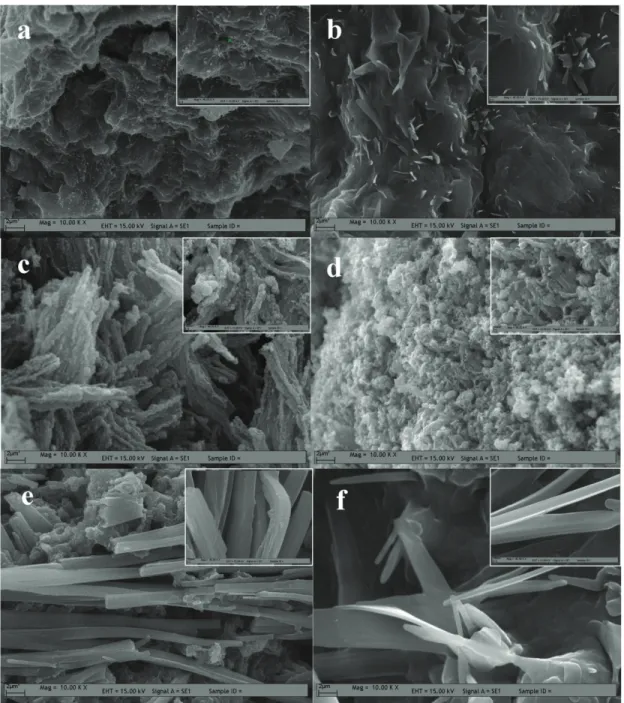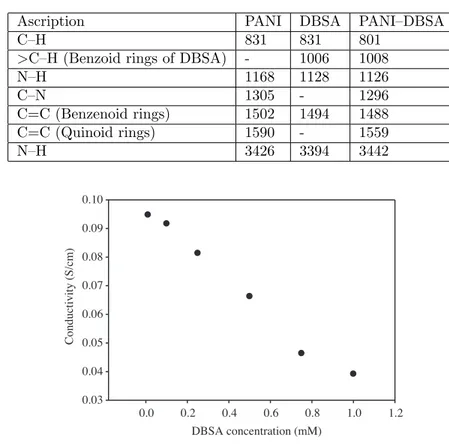c
⃝ T¨UB˙ITAK
doi:10.3906/kim-1411-16 h t t p : / / j o u r n a l s . t u b i t a k . g o v . t r / c h e m /
Research Article
Preparation and characterization of polyaniline microrods synthesized by using
dodecylbenzene sulfonic acid and periodic acid
Recep TAS¸1,∗, Muzaffer CAN2, Sava¸s S ¨ONMEZO ˘GLU3 1
Department of Chemistry, Gaziosmanpa¸sa University, Tokat, Turkey
2Department of Chemistry, Kırıkkale University, Kırıkkale, Turkey 3
Department of Materials Science and Engineering, Karamano˘glu Mehmetbey University, Karaman, Turkey
Received: 07.11.2014 • Accepted/Published Online: 10.04.2015 • Printed: 30.06.2015
Abstract: The preparation of polyaniline (PANI) microrod arrays in the presence of dodecylbenzene sulfonic acid (DBSAH), a structure-directing agent, and in the presence of periodic acid (H5IO6) , an oxidant in aqua-acidic media,
was investigated. DBSAH was performed to distinguish the roles of both surfactant and dopant. The method of preparation of DBSAH and H5IO6 doped PANI (DBSAH–PANI) microrods in a reversed micelle had previously not
been reported. The characterizations of the PANI microrods were determined by scanning electron microscopy (SEM), energy dispersive X-ray spectroscopy, (EDX) and X-ray diffraction (XRD). Based on the SEM results, we found that PANI microrods occur in the presence of DBSAH in the polymerization medium, while the XRD results showed that PANI–DBSA gave clearer crystallinity than PANI. At room temperature, the DC conductivities of pure PANI and PANI–DBSA were 9.5 × 10−2 S/cm and 9.2 × 10−2 S/cm–4 × 10−2 S/cm, respectively, based on the molar ratio of DBSA. The experimental results suggested that it is possible to control both the electrical conductivities and the crystal structures of PANI microrods with DBSAH dopants’ incorporation level.
Key words: Conducting polymers, polyaniline, dodecylbenzene sulfonic acid, microrods
1. Introduction
The discovery of electronically conducting polymers offers numerous new applications for polymeric materials.1 Conducting polymers have been intensively investigated for the last two decades, due to their fundamental physical properties and potential applications in various electronic devices such as chemical sensors, light emitting diodes, organic field effect transistors,2,3 electromagnetic interference shielding, antistatic materials, sensing materials, and secondary batteries.4−6
Polyaniline (PANI) is one of the members of the intrinsically conducting polymer family. Because of having a high molecular weight, PANI has been considered one of the most promising conducting polymers. In contrast to other conducting polymers, PANI exhibits good environmental stability and high conductivity,7,8 specifically as a simple and reversible acid/base doping/de-doping chemical property.9 However, the restricted ability to process PANI has limited its commercial application. In order to overcome this restriction, Cao et al.10 suggested the use of functionalized protonic acids, for instance, DBSAH and camphor sulfonic acid (CSA). Nowadays, micro- and nanostructures of PANI (tubes and particles) are prepared by the chemical
and electrochemical oxidative polymerization of aniline within templates11−13 or with structure directing agents.14−16 The synthesis of conducting polyaniline blends and composites is inexpensive. This method combines the processability of the insulated polymers and the electrical and redox properties of PANI.17 The preparation of oriented PANI nanostructures with controlled morphology has been reported previously.18 Yin and Yang19 stated that the use of a DBSAH/HCl reaction system may provide a facile route for the generation of 1D PANI nanomaterials, such as nanotubes and nanofibers, with high performance and in large quantities. Incorporation of nanoparticles in polymer blends has improved the properties of these materials for various applications, i.e. structural properties, thermal stabilities, mechanical and electrical properties, etc.20−22 Han et al.23 reported that PANI nanoparticles was successfully prepared from DBSAH micellar solution, in which DBSAH functioned both as surfactant and dopant, and that the particle showed a relatively well-ordered layered structure when aniline and DBSAH were used in appropriate molar ratios.
In the present research, the effects of DBSAH and HCl on the morphology and size of PANI microrods were investigated. PANI microparticles were prepared in aqua-acidic media in the presence of DBSAH and H5IO6. Different concentrations of DBSAH and H5IO6 are used as initiators to achieve reliable results. This was the first time that H5IO6 was used as an oxidant in the chemical synthesis of aniline/DBSAH polymers where aniline/DBSAH polymer was characterized by the use of SEM, EDX, UV-vis, FT-IR, XRD techniques, and dry conducting measurement. Therefore, we report the preparation and characterization of PANI microparticles from DBSAH micellar solution by using it as both a surfactant and a dopant. To the best of our knowledge, this is the first report on the synthesis of PANI microrods with H5IO6 by using DBSAH as a surfactant.
2. Results and discussion
2.1. HCl effect on formation of DBSAH-aniline microrods
The synthesis of PANI was investigated by using H5IO6, as an oxidant, and DBSAH, as a surfactant. The UV-vis spectra of 1.00 mmol concentration of each type for DBSAH, H5IO6, and aniline in aqueous media are separately presented in Figure 1. The absorption bands of H5IO6 and DBSAH are at 221 nm and 223 nm, respectively; however, aniline shows absorption bands at 230 nm and 280 nm. The band of aniline observed at 280 nm belongs to the n→ π * transition.24,25 H5IO6 and DBSAH are both weak acids, and aniline is a Lewis base. In order to determine if an acid-base reaction takes place between aniline–H5IO6 and aniline–DBSAH, the amounts of H5IO6 and DBSAH were increased from 1 mmol to 10 mmol for each aniline–DBSAH/H5IO6 sample. The UV-vis spectra of each mixture were obtained and are shown in Figures 2 and 3, respectively. As seen from these spectra, the intensities of the bands belonging to the n → π * transition decrease in the spectrum of aniline–H5IO6, in contrast to the trend seen in aniline–DBSAH. This indicates that there is an acid-base reaction occurring between aniline and H5IO6; on the other hand, an acid-base reaction does not take place between aniline and DBSAH.
Our early studies26 have shown that H5IO6 behaves as an oxidant only in the case of acidic media. In addition, acidic medium is considered to play an important role in the polymerization of aniline. H5IO6 and DBSAH are also weak acids as mentioned earlier. Therefore, HCl was used as a protonic strong acid to comprise an acidic polymerization medium.
Figure 4 shows the UV-vis spectra of the mixtures containing aniline–HCl samples with different HCl concentrations. The obtained results from aniline–H5IO6/DBSAH are compared only with HCl–aniline con-taining samples. As clearly seen from Figure 4, an increase in the amount of HCl (1 mmol–10 mmol) in the aniline solution results instantly in the disappearance of the absorption bands, belonging to aniline, in contrast
to other media. The HCl is a strong protonic acid in aqueous media, and, as a result, it reacts with aniline as a strong acid. Wavelength (nm) 200 220 240 260 280 300 320 340 A bs orba nc e 0 1 2 3 a b c Wavelength (nm) 200 220 240 260 280 300 320 340 A bs orba nc e 0 1 2 3
Figure 1. UV-vis spectra of a) aniline, b) DBSAH, and c) H5IO6 in aqueous media (the concentration of each type
is 1.00 mmol).
Figure 2. UV-vis spectra obtained with the addition of increasing amounts of H5IO6 to aniline solution (the
concentration of aniline is 1.00 mmol).
Wavelength (nm) 200 220 240 260 280 300 320 340 A bs orba nc e 0 1 2 3 4 Wavelength (nm) 200 220 240 260 280 300 320 340 A bs orba nc e 0 1 2 3 4 a b
Figure 3. UV-vis spectra of solutions prepared by adding DBSAH to the solutions containing 1.00 mmol aniline (the amount of the DBSAH added is more than that of the aniline).
Figure 4. UV-vis a) spectrum of solution containing 1.00 mmol aniline, b) spectra of solutions prepared by adding HCl to the solutions containing aniline (the amount of the HCl added is more than that of the aniline).
Figures 5 and 6 present the UV-vis spectra of HCl to which were added aniline–H5IO6 and aniline– DBSAH mixtures, respectively. The absorption band at 280 nm belonging to aniline disappears with the addition of HCl. Moreover, a white precipitate was seen with the addition of HCl to the aniline–DBSA mixture in contrast to that of the aniline–H5IO6 mixture. On the other hand, no precipitate was formed in the solutions containing aniline–H5IO6 or aniline–DBSAH. It can be concluded that the white precipitate might be anilinium dodecylbenzene sulfonate (Ph-NH+3DBSA−) , since sediment was not observed in the case of the solution containing aniline–DBSAH or aniline–HCl.
Wavelength (nm) 200 220 240 260 280 300 320 340 A bs orba nc e 0 1 2 3 Aniline+H5IO6 a b Wavelength (nm) 200 220 240 260 280 300 320 340 A bs orba nc e 0 1 2 3 Aniline+DBSA a b
Figure 5. UV-vis spectra of a) 1 mmol aniline + 1.00 mmol H5IO6 mixture, b) solutions prepared by adding
HCl to the solutions containing the aniline and H5IO6
(the amount of the HCl added is more than 1.00 mmol).
Figure 6. UV-vis spectrum of a) aniline–DBSAH mix-ture, b) spectra of solutions prepared by adding HCl to the solutions containing 1.00 mmol aniline and 1.00 mmol DBSAH (the amount of the HCl is more than 1.00 mmol).
Figure 7 exhibits the EDX spectrum of the white sediment obtained from aniline–Ph–NH+3 DBSA−. This experiment was conducted to confirm whether or not the white sediment is anilinium dodecylbenzene sulfonate, Ph-salt. The corresponding S peak proves the existence of DBSA− in the polymer matrix. As seen in the spectrum, there is also a small amount of Cl, which is less than the content of S in the salt. The excess of chloride resulted from Cl− adsorbed on the surface of salt or trapped in this salt as anilinium chloride during the reaction procedure. Furthermore, the SEM image of Ph-NH+3DBSA− salt is shown in Figure 8. The white salt has a crystalline and rod structure. It can be concluded that HCl acts as a catalyst during the formation of the salt shown in Scheme.
Acid-base reactions, which can be written according to the results obtained, are given in Scheme.
NH2 H3C(H2C)11 SO3H (will not precipitate) (DBSAH) H5IO6 + NH2 NH3+ HCl + NH2 NH3+Cl - (aq) NH3+Cl - NH3 SO3 NH2 + HCl DBSAH + HCl (white precipitate) + (equilibrium reaction) (one-way reaction) Scheme.
Figure 7. EDX spectrum of Ph-NH+3 DBSA− salt obtained from the aniline + DBSAH + HCl mixture.
Figure 8. Scanning electron micrograph (SEM) image of Ph-NH+
3DBSA− salt.
Figures 9 and 10 show the EDX spectra of the black polymers that were observed when oxidizing agent (H5IO6) was added to the aniline–HCl mixture and the aniline–DBSAH–HCl mixture. The EDX spectra of the black polymers show the existence of Cl and I (doped as I−3) in the structure of polymer synthesized containing aniline and HCl, and the existence of S (doped as DBSA−) and I (doped as I−3) in the structure of polymer synthesized containing aniline, DBSAH, and HCl. The dopant substance is I−, which causes decomposition of H5IO6, without DBSAH medium. When DBSAH exists in polymerization medium, dopant substances are both DBSA− and I−. Cl observed in the EDX spectrum might be adsorbed and/or trapped Cl as maintained above.
2.2. Effect of DBSAH concentration on formation of polyaniline microrods
In the presence of 1.00 mmol aniline, a series of solutions with different amounts of DBSAH (0.0, 3.0, 5.0, 7.50, and 10.0 mmol) were prepared. The solution of oxidizing agent (H5IO6) was added by means of a dropping funnel into the mixtures. To terminate the polymerization reactions, a certain amount of methanol solution was added to each polymerization solution after 10 h. The black polymers were filtered and then washed with a water–methanol mixture to remove any residual monomers, oxidants, and HCl.
Figure 9. EDX spectrum of polymer obtained by adding H5IO6 to the aniline + HCl mixture.
Figure 10. EDX spectrum of the polymer obtained by adding H5IO6 to the DBSAH + HCl + aniline mixture. When PANI was synthesized without the use of DBSAH medium, the PANI was isolated in a large quantity and then it was collected through filtration. If the same synthesis took place in the presence of DBSAH, the PANI particles were easily able to pass through filter paper. This indicates that DBSAH has an effect on the particle size of polymer. In Figure 11, the synthesized PANI polymers, dried under a vacuum, show XRD patterns. In Figure 11a, a broad peak was observed with a maximum around 19.87◦, which was a characteristic peak of the amorphous emeraldine base form of PANI.23,27 With an increase in the amount of DBSAH in PANI, a transition from amorphous to crystalline phase can be clearly seen (Figures 11b–11f). On the other hand, DBSA–PANI (Figure 11f) showed a peak of 2 θ = 20.08◦ along with different peaks at 2 θ = 6.04◦, 21.12◦, 23.94◦, 18.22◦, 25.36◦, etc. Among these peaks, the one at 2 θ = 25.36◦ may be ascribed to periodicity perpendicular to the polymer chain.23,28
The SEM images of PANI with the different amounts of DBSAH are given in Figure 12. As shown in Figure 12a, the PANI without DBSAH consists of sponge-like particles. However, from the high-magnification inset image in Figure 12a, a little amount of rod-like white particles small in size are found in the microstructure. The size and amount of these particles increased with an increase in the amount of DBSAH in PANI (Figures 12b–12f). Moreover, the morphology of particles transforms into rod structure with sharp edges, which indicates a crystalline phase. These observations are in good agreement with XRD analysis. The SEM images and
discussion above indicate that when the amount of DBSAH is increased in the polymerization medium, the crystallites of polymer also increase, and, at the same time, PANI is transformed into the rod structure.
Figure 11. XRD spectra of polymers synthesized from solutions containing 1.00 mmol aniline, 1.0 mmol H5IO6, and
1.0 mmol HCl, a) pure PANI, b) 1.0 mmol DBSAH, c) 3.0 mmol DBSAH, d) 5.0 mmol DBSAH, e) 7.5 mmol DBSAH, f) 10.0 mmol DBSAH.
The FT-IR spectra of PANI, DBSA, and PANI–DBSA are presented in Figure 13. In the PANI spectra, characteristic broad absorption peaks are seen at 1590 cm−1 and 1504 cm−1, corresponding to a C=C stretching quinoid ring and C=C bond stretching benzenoid rings,29 respectively. On the other hand, the characteristic broad absorption peaks found at 1489 cm−1 correspond to stretching vibration of the benzonide ring, and 1559 cm−1 is assigned to the stretching of C=C bonds of the quinoid ring23 in the case of PANI– DBSA. Furthermore, peaks in the spectra of PANI–DBSA can be clearly seen at 1033, 2922, and 1008 cm−1, corresponding to S=O stretching, C–H stretching of –CH2 and > CH stretching of benzenoin rings in the DBSA molecule, respectively. These corresponding peaks could also be observed in the spectrum of DBSA. Therefore, it can be stated that these results corresponded to doped PANI–DBSA. In a substance, the formation of PANI–DBSA can be verified by the FT-IR spectra. The Table presents the characteristic absorption peaks shown for PANI, DBSA, and PANI–DBSA.
Figure 12. Scanning electron micrograph (SEM) image for polyaniline synthesized solution containing 1.0 mmol aniline, 1.0 mmol H5IO6, and 1.0 mmol HCl a) no DBSAH, b) 1.0 mmol DBSAH, c) 3.0 mmol DBSAH, d) 5.0 mmol DBSAH,
e) 7.5 mmol DBSAH, f) 10.0 mmol DBSAH.
Figure 14 exhibits the dry conductivities of the polymers that were synthesized with solutions containing 1.00 mmol aniline and with an increase in the amount of DBSAH. The dry conductivity values decrease with an increase in the DBSAH concentration based on Figure 14. As discussed previously, DBSAH increases crystallites of polymer, but it prevents the growth of polymer and hence the growth of polymer conjugation, so that low conjugation polymers have low conductivity.
Figure 13. FTIR spectra of polymers synthesized in solutions containing a) 1.0 mmol aniline, 1.0 mmol H5IO6, and
1.0 mmol HCl; b) 1.00 mmol DBSAH; c) 1.0 mmol aniline, 1.0 mmol H5IO6, 1.0 mmol HCl, and 10.0 mmol DBSAH.
Table. The characteristic wave numbers belonging to FTIR spectra of PANI, DBSA, and PANI–DBSA.
Ascription PANI DBSA PANI–DBSA
C–H 831 831 801
>C–H (Benzoid rings of DBSA) - 1006 1008
N–H 1168 1128 1126 C–N 1305 - 1296 C=C (Benzenoid rings) 1502 1494 1488 C=C (Quinoid rings) 1590 - 1559 N–H 3426 3394 3442 DBSA concentration (mM) 0.0 0.2 0.4 0.6 0.8 1.0 1.2 Conduc ti v it y (S /c m ) 0.03 0.04 0.05 0.06 0.07 0.08 0.09 0.10
Figure 14. Conductivity change of the polymers synthesized in solutions containing 1.00 mmol aniline and increasing amount of DBSAH.
3. Experimental 3.1. Equipment
Aniline (97%, purchased from Aldrich) was distilled before used and stored in a refrigerator. Periodic acid (99%, purchased from Sigma-Aldrich), hydrochloric acid (37%, purchased from Merck), and dodecylbenzene sulfonic acid (purchased from Sigma-Aldrich) were used without further purification. UV-vis spectra of the PANI in aqueous media were recorded in the range of 200–600 nm using a PerkinElmer Lambda-35 UV-vis spectrophotometer. Infrared spectra of the polymers were obtained in the range of 2000–400 cm−1 using a Jasco FTIR-430 Fourier Transform Infrared Spectrometer. X-ray diffractions of the powdered polymer samples were acquired by a Rigaku D/MAX-2200 diffractometer using CuK α radiation from 2 to 50◦ (2 θ) at a scanning rate of 4 min−1. Polymer samples were subjected to a thin gold coating by using a Zeiss Evo-50 fine coater for SEM measurements. Before DC conductivity measurements, dry pellets were prepared from powdery polymer material under a pressure of 5 t cm−2. The dry conductivity values of polymers were measured by using a four-probe electrical conductivity measuring device (Entek Electronic) at room temperature. Gold-plate probes were used to avoid any errors caused by ohmic contacts. The resistivity of the samples was measured at five different positions and at least two pellets were measured for each sample: an average of 10 readings was used for conductivity calculations. If probes with uniform spacings are placed on an infinite slab material, then the resistivity, ρ , is given by
ρ = 2πsV /I Ohm-Centimeters for t >> s (1)
ρ = (πt/ ln 2)V /I Ohm-Centimeters for s >> t, (2) with t representing the thickness of the thin film. We calculated the conductivity according to the first equation due to t >> s.
3.2. Synthesis of polymers
For the synthesis of PANI, a round bottom flask was charged with aniline, 1 mmol of HCl, and DBSAH (0.0, 3.0, 5.0, 7.50 and 10.0 mmol). Then 1 mmol of H5IO6 was added to the reaction mixture and it was stirred at room temperature for 10 h. A dark green colloidal solution was obtained upon addition of the oxidant. The resulting dark green polymers were collected through filtration. The colloidal polymer samples were subjected to multiple rinsing procedures with distilled water to remove any residual monomers, such as oxidant and HCl, and then dried under a vacuum.30
4. Conclusions
This synthetic approach represents a novel route to prepare DBSAH and H5IO6 doped polyanilines. It used DBSAH and H5IO6 together for the first time in the synthesis of polyaniline. Investigation of the polymerization of aniline with consideration of the effect of DBSAH took place in this research study. PANI polymer was synthesized in different media, and characterized by using UV-Vis, XRD, SEM, EDX, and a conductive measuring tool. As defined earlier, DBSAH affects both the morphology and size of a polymer. As the amount of DBSAH in polymerization solution is increased, crystallite of polymer increases and polymer synthesized in this medium has a microrod arrays structure.
Overall, based on the results collected in this study, it can be concluded that the polymer, having the desired size and crystallite, can be synthesized by controlling the DBSAH concentrations in polymerization solutions.
Acknowledgment
The authors want to thank the Scientific Research Commission of Gaziosmanpa¸sa University for its financial support.
References
1. Trivedi, D. C.; Nalwa, H. S. Handbook of Organic Conductive Molecules and Polymers vol. 2 ; Wiley: Chichester, UK, 1997.
2. Anand, J.; Palaniappan, S.; Sathyanarayana, D. N. Prog. Polym. Sci. 1998, 23, 993–1018.
3. Somani, P. R. Mater. Chem. Phys. 2003, 77, 81–85.
4. Sonmezoglu, S.; Durmus, C. B.; Tas, R.; Cankaya, G.; Can, M. Semicon. Sci. Technol. 2011, 26, 055011–055017.
5. Sonmezoglu, S.; Senkul, S.; Tas, R.; Cankaya, G.; Can, M. Thin Solid Films 2010, 518, 4375–4379.
6. Sonmezoglu, S.; Senkul, S.; Tas, R.; Cankaya, G.; Can, M. Solid State. Sci. 2010, 12, 706–711.
7. Mathew, R.; Yang, D. L.; Mattes, B. R.; Espe, M. P. Macromol. 2002, 35, 7575–7581.
8. Ghosh, P.; Siddhanta, S. K.; Haque, S. R.; Chakrabarti, A. Synth. Met. 2001, 123, 83–89.
9. Huang, J. X.; Virji, S.; Weiller, B. H.; Kaner, R. B. J. Am. Chem. Soc. 2003, 125, 314–315.
10. Cao, Y.; Smith, P.; Heeger, A. J. Synth. Met. 1992, 48, 91–97.
11. Martin, C. R. Chem. Mater. 1996, 8, 1739–1746.
12. Parthasarathy, R. V.; Martin, C. R. Chem. Mater. 1994, 6, 1627–1632.
13. Wu, C. G.; Bein, T. Science 1994, 264, 1757–1759.
14. Wei, Z. X.; Zhang, Z. M.; Wan, M. X. Langmuir 2002, 18, 917–921.
15. Yang, Y. S.; Wan, M. X. J. Mater. Chem. 2002, 12, 897–901.
16. Choi, S. J.; Park, S. M. Advan. Mater. 2000, 12, 1547–1549.
17. Nazarzadehzareh, E.; Najafi, M. P.; Azariyan, E.; Sharifian, I. Iran. Polym. J. 2011, 20, 319–328.
18. Xia, H. B.; Chan, H. S. O.; Xiao, C. Y.; Cheng, D. M. Nanotech. 2004, 15, 1807–1811.
19. Yin, H. J.; Yang, J. P. Mater. Lett. 2011, 65, 850–853.
20. Becerik, I.; Fı¸cıcıo˘glu, F.; Kadırgan, F. Turk. J. Chem. 1998, 22, 91–96.
21. Kafshgari, M. H.; Khorram, M.; Mansouri, M.; Samimi, A.; Osfouri, S. Iran. Polym. J. 2012, 21, 99–107.
22. Amirian, M.; Chakoli, A. N.; Cai, W.; Sui, J. H. Iran. Polym. J. 2012, 21, 165–174.
23. Han, M. G.; Cho, S. K.; Oh, S. G.; Im, S. S. Synth. Met. 2002, 126, 53–60.
24. Wessling, B. Synth. Met. 1998, 93, 143–154.
25. Sato, H.; Kusumoto, Y.; Arase, S.; Suenaga, M.; Kammura, S. J. Phys. Chem. 1978, 82, 66–68.
26. Can, M.; Uzun, S.; Pekmez, N. O. Synth. Met. 2009, 159, 1486–1490.
27. Li, N.; Li, X. T.; Geng, W. C.; Zhang, T.; Zuo, Y.; Qiu, S. L. J. Appl. Polym. Sci. 2004, 93, 159–1601.
28. Cao, Y.; Smith, P.; Heeger, A. J. Synth. Met. 1992, 48, 91–97.
29. Ghosh, P.; Siddhanta, S. K.; Chakrabarti, A. Eur. Polym. J. 1999, 35, 699–710.
